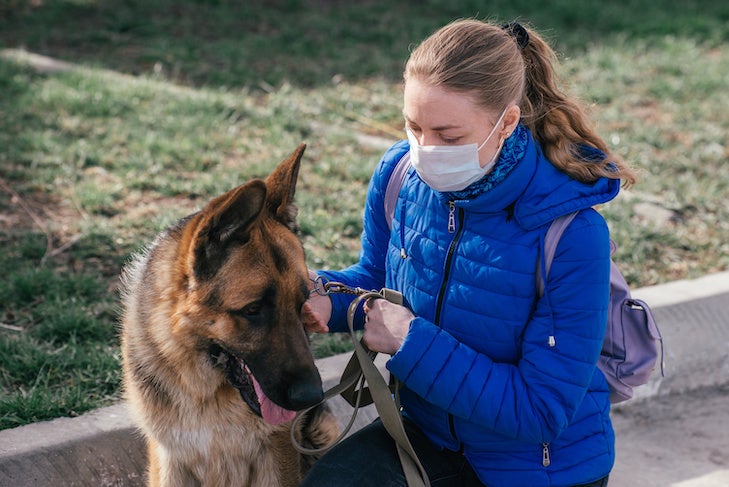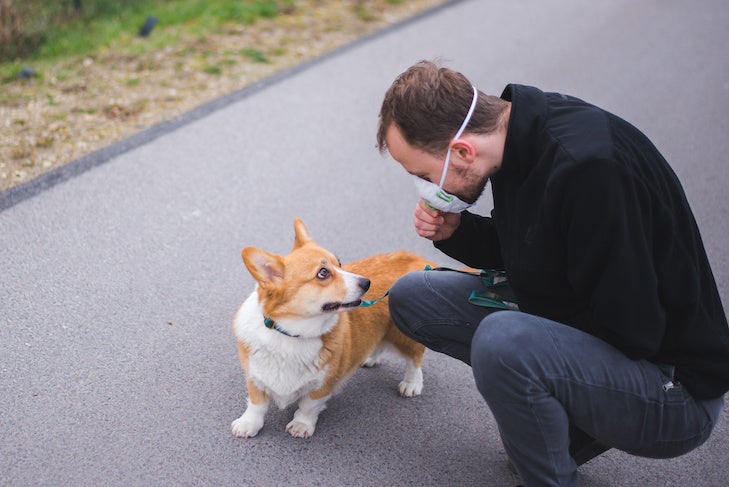
From the Lone Ranger to Zorro, we know good guys can wear masks.
But just try convincing your dog of that.
As controlling the spread of the coronavirus becomes a paramount concern, the federal government has recommended – and some states have mandated – wearing face masks in public. While we humans have acclimated to the sight of friends and strangers alike wearing various face coverings – from surgical and respirator masks to scarves and bandanas – our dogs haven’t gotten the memo. And even if they did, they wouldn’t be able to read it.
As various parts of the United States slowly reopen over the coming weeks and months, dog owners need to be aware of the challenges that face coverings pose to dogs who have never before been exposed to them.
See life through a dog’s eyes
“As much as we talk about dogs being scent focused, a lot of how they engage with us is based on our faces,” says Gayle Watkins of Highlands, North Carolina, a dog trainer and founder of Avidog International. Indeed, unlike wolves, who avoid eye contact with humans, dogs have evolved to read our faces to determine our moods – all the better to get along with us.
“Dogs read subtle muscle changes that indicate a twitch or a smile, and they read them much faster than we do,” says Watkins, who also breeds Golden Retrievers and is a Gold-level AKC Breeder of Merit. “They lose all that when you’re wearing a mask.”
Know the difference between desensitizing and overwhelming
Just as you don’t learn to swim by being tossed off the deep end of a pool, you can’t expect a dog to become comfortable with a face-masked human by thrusting him into a room full of them.
Instead, systematic desensitization is key. “You are exposing the dog to the mask at a controlled level, always making sure the dog is comfortable and only moving to the next step when the dog is ready,” explains Vicki Ronchette, a certified professional dog trainer and owner of Show Dog Prep School in California’s San Francisco Bay area.
Ronchette says signs of discomfort vary based on the individual dog, and might include growling, backing away, trying to escape or leaning away. Of course, she reminds, there are varying levels of all these responses, indicating everything from mild concern to panic.
Accentuate the positive
The key to introducing any potential trigger is to link it with the idea that “good things are happening,” Watkins says.
For starters, you might simply put a mask next to your dog’s dish during mealtime, or tape it on the wall above his food bowl, in the same horizontal position in which you would be wearing it. To demystify this new object, “show your dog the mask,” Watkins advises. “Let him sniff it.”
Next, she says, start sort of wearing the mask: Let it hang from your ear, or wear it on your forehead, or under your chin – but not blocking your mouth yet, so your dog can still decode the important non-verbal communication coming from your mouth.
After lots of repetition of these short, positive sessions, and once your dog has associated the mask with good things being showered into his life, start wearing the mask for short periods. “Put the mask on and walk to the cookie jar,” Watkins suggests. “Wear it when you feed, play and cuddle with your dog – at times when the dog is comfortable and happy. Very soon the mask will be a positive thing, and the dog will quickly conclude that the mask is a just new part of life.”

What about the doubters?
Dogs are individuals, and some might not take readily to you wearing a mask. Some breeds are also naturally more visually oriented or attuned to changes in the status quo, and might need more time to get comfortable.
In such cases, “the most important thing is not to force or push the dog,” Ronchette says. “Force cannot help with fear. It will only increase the dog’s anxiety and likely create issues in the relationship between the person and the dog, because the dog’s concerns are being ignored.”
With these caution canines, go back to basics, reintroducing the dog to the mask by itself, without wearing it. Ronchette also suggests little “mask games,” like pulling your shirt over half of your face, and then letting it drop while playing or giving treats.
One caveat: “If the dog is afraid of the mask, do not try to use food to lure the dog to you,” she advises. “This will create conflict for the dog, as he may be willing to come close to what scares him just to get the food.” Instead, go back to a point where the dog is comfortable, and build on that.
Signal your satisfaction
Watkins notes that wearing a mask curtails communication with your dog in two ways: It muffles your words of praise and it prevents the dog from seeing you smile.
She suggests borrowing a tactic from owners of deaf dogs: Teach a hand command that sends the same message, such as raising your index and middle fingers like a peace symbol and rocking them back and forth. Just as when you introduced the mask, pairing that signal with a treat will soon teaches the dog that it means “Good dog!”
When you’re wearing a mask, what goes on above your nose takes on a greater impact to a dog scanning your face for clues about your mood. Dogs are especially attuned to the difference between “soft” and “hard” eyes. Try to increase your awareness of tension in your face: When you encounter a stressful situation, take a deep breath, soften your face, get your dog’s attention, and praise him with both your newly taught “good dog” signal, as well as your voice.
Expand your dog’s horizons
If there are other people in your household, they should interact with your dog while wearing masks, too, so the dog understands the mask is not unique to one person. Similarly, expose your dog to different colors and styles of masks, as well as over face coverings such as bandanas and ski masks.
Some masks might be more triggering than others. For example, “those pointed black masks and respirators that look like dog muzzles seem like a really bad idea to me,” Watkins adds. “To a dog, it looks like a Rottweiler’s muzzle on a person’s head.”
Your dog also needs to learn that masks on strangers are normal, too. Watkins suggests driving with your dog to the parking lot of a busy grocery store. Wear your mask, and just hang out together inside the car, she says. “Let your dog see people go in and out. Feed him treats, tell him he’s a good dog with your signal, and then go home.”
Facing your dog’s fears
Dog trainer and Sussex Spaniel breeder Pluis Davern of Royal Oaks, California, who was the AKC’s 2011 Breeder of the year, reminds that as warm weather approaches, dogs will be seeing even less of our faces. “In summer, people will be wearing sun visors and sunglasses as well as masks,” she says. “Then the dog can’t read anything on their faces.”
The solution? The same repetitive, low-stress, high-reward exposure outlined above for introducing the mask, adding one new element at a time. While all this sounds time-intensive, it is well worth the effort to make your dog comfortable with just one aspect of what is quickly becoming the “new normal” in our human world.
The AKC is here to help owners with questions and concerns about COVID-19 and dogs. Find answers to your questions, plus at-home activity ideas, training tips, educational resources, and more on our Coping With COVID-19 hub.

